Stories from Bob Dylan's First Never Ending Tour Sound Crew
David Robb, Keith Dircks, and Fuzzy Frazer talk Bob on the road in the late '80s
Flagging Down the Double E’s is an email newsletter exploring Bob Dylan shows of yesteryear. Some installments are free, some are for paid subscribers only. Sign up for either option here:
Update June 2023: One of these interviews is included along with 40+ others in my new book ‘Pledging My Time: Conversations with Bob Dylan Band Members.’ Buy it in hardcover, paperbook, or ebook now!
Last fall, I did a couple interviews with people on the road with Bob Dylan during the very first shows of the Never Ending Tour in 1988: Drummer Christopher Parker, Tour Manager Richard Fernandez, Stage Manager Mark Spring. That not-really-a-series continues today with a three-in-one. I spoke to Dylan’s sound guys from those days: David Robb, who did the sound the audience heard; Keith Dircks, who did the sound the band heard, and Robert “Fuzzy” Frazer, who got the gear from place to place and helped with mics.
Now, you should know going in: Their jobs did not require much close interaction with the man himself. There are a couple Bob anecdotes sprinkled in, but, to me, their stories are most interesting as a window into what daily life was like if you’re a crew guy on the road with Bob. In some ways, it probably hasn’t changed that much in the years since.
If you’ve ever gone to a show and wondered what the people scurrying around onstage before Bob comes on are doing, or what the people standing behind those giant boards are actually up to, David, Keith, and Fuzzy help break it down.
David Robb, Front of House:
I started working with Al Santos in 1980, when he was production manager for Frank Zappa. The two of us ended up working together on tours for pretty much all of the '80s. We did three years of Zappa, then we went to Tom Petty, then Yes, and then Dylan. Interestingly enough, Al is still Bob Dylan's production manager to this day, 30-whatever years later.
I actually did a short tour with Bob in '86 when he did a month or so of dates that summer with Tom Petty and the Grateful Dead. I was out with the Dead at that point. I had never seen Bob live prior to that.
Then came the actual Never Ending Tour that started in May of '88. I went to two or three days of rehearsals in New York City when that started. The three-piece band who started that rehearsal did not have Kenny Aaronson on bass. Instead, they were trying out Marshall Crenshaw. Marshall and [drummer Chris Parker] were both living in Woodstock at that time, as was I, and I drove their equipment down to rehearsals. I think it was either after day one or in the midst of day two, Bob said that's not what he wanted. Then [guitarist] G.E. Smith got Kenny Aaronson to come in, and Kenny was with him for the rest of that tour, and I think the next one after that.
I felt very comfortable with being able to get a decent sound out of this group, and so I was just watching, understanding how Bob worked, how he worked with the band, figuring out the potential politics, and everything else.
What do you mean politics?
Well, how do the band members relate to Bob? How does he relate to them? How do songs get structured? Are they learning things exactly from him, or is he just giving them cues? Bob is probably one of the least structured musicians that I've ever worked with.
The very first show was at the Concord Pavilion out in California [on June 7]. The mix position at Concord was not ideal, and we couldn't set up the entire system that I had brought along. I wasn’t completely satisfied with the way I pulled off that first show, but things got better from there on.
I knew the lyrics to his tunes were very, very important to the people that like him as an artist. Honestly, I don't pay much attention to lyrics with any of the acts that I work for. When the band is playing, I'm not listening for the lyrics, but I am listening to be sure that the vocal is well placed with the instruments and is highly intelligible. Some artists even say, "Turn my voice down a little bit. I want to hear the guitar or the keyboard just as strong," but for Bob, I really felt that, to have an intelligible lyric, his voice needed to sit on top of anything else in the mix.
My mixing style was a bit unusual. Most people mixing FOH [front of house] have maybe a two to four-foot riser so that they can sit up there and see over the heads of the audience and watch the stage while the show is on. I feel the reason that the mix position is out in the house is so that the person operating the equipment gets the same experience as the audience. For that reason, I never used any risers. I would put my console right down on the floor. If the audience was sitting down, I'm sitting. If the audience is standing up, I'm standing.
For the Dylan gigs, that was great news for the promoters, because when you have a lot of equipment all up on a riser, there's a whole bunch of seats behind that riser that are blocked. When they saw that I was at the same level as everybody else, they said "Great, that just opened up a bunch of seats that I can sell."
On a typical show day schedule:
One of the many positions I’ve held on tours was ground rigging. Knowing where the stage is laid out, and exactly where the audience is going to be determines where I'm going to rig the sound system. Lighting needs to get rigged and up in the air and out of the way [first], because otherwise you're all tripping over each other.
Sometime after that, the sound will come in, and we'll roll all that gear to its proper places and start rigging the sound, lifting it up into the air, and aiming it in the right places.
After lunch, the band's equipment gets on stage, and everything is all set up. Then we mic everything and check all the lines. After the system is fully up, I'll do some quick checks of the coverage in the room, and do some equalization, play a little bit of music, a little bit of pink noise, test the abilities of the system and how it’s going to work in the room.
What is pink noise?
Pink noise is an electrical signal with a predictable average waveform. It consists of all the frequencies that the ear can hear, all playing at the same time. If you listen to it, you don’t hear actual notes; it sounds a lot like the static between stations on a radio. It’s used in testing audio gear, where you monitor how the waveform is affected as it passes through the device.
When you go into a venue, your loudspeakers are all aimed in different directions. Say you're in a hockey rink or something similar, you’ll get a lot of reverberation, reflections off the walls and ceiling. If you take an audio signal and play it through the system, then you use a microphone to capture what's coming out, it helps you understand how the room is affecting the sound.
Four or five o'clock in the afternoon, the band would typically show up for a soundcheck, where they would go on stage and noodle around a little bit. Sometimes, especially near the beginning of a tour, you might bring them on the stage one at a time. Drums, in particular. A drum kit could have between half a dozen and several dozen mics on it, so trying to listen to each one, it takes a while to do that. After a few shows , you can usually just let the band play whatever they want at soundcheck.
Dylan was unique in that he rarely did a soundcheck. He didn't need to rehearse songs. He wrote them. He knows them. He’s probably going to play them different tonight than he has played them before. I've talked to G.E. about this. You might know the entire Dylan repertoire, you might have listened to every single thing he recorded, but it's not going to be what you're playing tonight.
On occasion, Bob might come out and check his electric guitar. He would rarely check his acoustic guitar; I would usually get G.E. to play Bob's acoustic guitar after Bob walked off the stage. There wasn't a lot of learning or rehearsing songs. After the soundcheck was over, Al Santos would usher the band off the stage. Then we would quickly set the stage for the opening act and try to give them a short soundcheck before it was time to open house doors.
Bob and G.E. would make a setlist, then Al Santos would make copies of that for everybody. There would be one out there for each one of the musicians. I would get one, the lighting guy would get one, the monitor guy. They were an interesting guide, but you certainly wouldn't want to bet the bank whether Bob was going to stick to that list.
G.E. would stand to Bob's right, just about up at the same position with him. You would think as a side musician, he'd be standing back, but he couldn't really do that. For the entire show, he would be watching Bob's hands to figure out when he was going to change the chord and what chord was it going to be. G.E. would take his cues from that. Sometimes, he would call something across to Kenny so that Kenny would know what key they were playing in.
I might have to guess what song he was going to do next, but it didn't really make much difference for me. I used very few effects on Bob’s voice or his instruments. Before the Bob tour, I was out mixing Yes, and I really needed to know what the next song was, because there are a lot of different things I would change in the mix. But for Bob, it's a four-piece band. They're not going to do much that’s different unless G.E. and Bob switch from electric to acoustic, and that's pretty obvious.
I pride myself with watching, in addition to listening. That's one of the things I've told people when they ask me “what's the trick to mixing?” You try to get it to sound as good as you can, but then stop for a minute and stare at the stage, look at every single thing on the stage that is making some kind of sound, and make sure that you can hear that in its proper place in the mix.
The mix did not change a lot, the effects didn't change, there were no real cues. There weren't even cues for starting a song. You'd think maybe Bob was tuning his guitar, and then all of a sudden he's playing a couple of chords, and by that time G.E. starts to play, and okay, the song has started. That's much more of an issue for a lighting person.
I had virtually zero interaction with Bob. He keeps to himself. I don't know how he is with just the band when they're alone, but anytime that he was in the venue, there would be very little communication. Of course, I'm probably in the worst position because I'm out front at the house console. He might have a comment for our monitor engineer who is a few feet away from him, but he's not coming out to talk to me.
That does bring up the one real interaction that I had with him, which was fascinating. The tour was at Fiddler's Green, which is an outdoor amphitheater near Denver. Early in the afternoon, Al Santos said that we may get some weather, and that it could be serious.
Just before the soundcheck, I looked up over the mountains and you could see a tornado starting to form. It was the strangest thing. It looked like somebody up above the clouds had this huge black ice cream cone and was just sticking it down through the clouds and then pulling it back up again. Down and up, down and up.
Then all of a sudden this black cone came all the way down and hit the ground. It went all the way back up again, and then it stopped. This place where it hit the ground was miles away from where we were, but we could see this very clearly.
After the soundcheck, I went into the caterers. I was sitting down eating dinner, and the unheard-of happened: Dylan walks into catering and comes over and sits at the table with me. We proceeded to have this 20-minute discussion about how the tornado affects air pressure, and how the air pressure could affect the sound. I'm not sure if he was concerned that the sound would be a problem. I think he was probably more scientifically curious: What does something like that do to sound?
I was stunned at the fact that he was interested in it, and that he was breaking his general routine of sitting on the bus by himself and not talking to anybody. It was by far the longest interaction I ever had with him.
At a later show, we were at the Garden State Arts Center, in New Jersey. In the middle of Bob's set, somebody is tapping me on the shoulder. I was ready to just slap their hand away, but I look over and it's [Bob’s] manager. He said, "I have an artist that I'm about to sign, and I want them to sit here and hear Bob for just a song or two." I said, "All right, but don't let them bother me." He went away and then there was a bit of motion behind me. I finished the song, looked back, and there's Tracy Chapman. Sure enough, she did become his client. I actually ended up mixing for Tracy after Bob.
Another memorable show was the very last show of the tour. We ended it doing four nights at Radio City Music Hall. The final night, we get a couple of songs into it, and I’m getting comfortable. It’s the last day of the tour and we’re four days in the same venue, so I think I know what to expect.
I happen to lean forward in my seat and look around the corner of the equipment rack sitting next to me. On the other side of the rack are several theater seats which are blocked off for the opening act console. I can just see these hand-painted sneakers tapping away on the floor. I said to myself, "Oh, great, some guy from the cheap seats has climbed into the empty seats to the side of me.” I’m worried they're sitting there playing with the $100,000 worth of electronics, and I’m pissed. I stand up and look over the rack, ready to have this person thrown out. It's George Harrison.
After that same show, Al Santos said that Bob wanted to see us. Just Santos and me. I was like, "Really?"
The two of us walked a few blocks up to the Russian Tea Room, the famous restaurant. We saw Bob’s bodyguard standing out on the sidewalk, and he waved us over. He opened up a private door and we went upstairs to a little banquet room. I think there were just six or eight people sitting in that room, including Bob.
The two of us walked in. His manager told us, “Bob wanted you up here to thank you for the tour.”
A lot of artist managers just book the gigs and then they are back in their office doing other things, but Bob’s manager was with him all the time. He was his mouthpiece.
At that point, the other people in the room stood up and gave a little bit of applause for the work that we had done. If I remember correctly, the small group included Peter Gabriel, Rosanna Arquette, and George Harrison.
I guess in the back of my mind I thought, “Oh, now they’re going to give us a big bag of money here,” but that never happened. No big bonus. But it was nice to be thanked.
1988-06-15, Fiddler's Green Amphitheatre, Denver, CO
Keith Dircks, Band Monitors:
I did monitors, so I worked 22 feet away from him. In the first year, he said maybe 40 words to me. Truly.
When I first met him, we were in the [rehearsal] studio, Montana Studios in New York. Dave was in another room with the front of house console, and I stayed in the rehearsal room with the monitor console. The band had showed up first, like the day before.
When Bob came in, I asked him, "What's your philosophy on monitors?" His reply was, "All around…"
And so that's what I had to work with.
At first [he was all], "Turn that down. I don't want that, I don't want that." Then we went and did the first show in some shed. Management called me to his suite the next morning. I was getting fired, because Bob hated the monitors. And Dave interjected and said, "Well, what don't you like?" And he goes, "Well, they weren't loud enough." And Dave goes, "Really? You want loud?"
At the second show, [Dylan's manager] Elliot Roberts was next to me. Because now I'm on thin ice. After the third song, he goes, "Turn that shit down!" Nothing was ever said again about how I did monitors.
You know, Bob's just a guy of few words. One thing stood out out of the 40 words he spoke at me in the first year. We were up in Montana Studios, and it was just him and I in the room. I'm at the back of the room doing something. He walked back, and he goes, "When it's all said and done, it comes down to two things." And then there was a long pregnant pause. You know, the Bob pause. Then he said "Kids and food," took a bite out of a jalapeño, turned around, and walked away.
The next year, in '89, my first daughter was born. And 25 years later, god damn, he was right on. It's all about kids and food. He had totally nailed it. I couldn't appreciate it at the time. I kind of went, well okay, that's a Bob-ism. But then, 25 years later: oh, I guess he had something to say.
In the States, the crew all had mountain bikes, and we took them on tour with us. And whenever you had an hour to get away, you just go for a ride. When we went to Europe, the crew didn't take any of their bikes, but Bob and his entourage got bikes in Europe to peddle around. Every time that they did, they left the bikes unlocked, and they would get stolen. So in the next country, they'd have to buy another set of bikes.
There were not a lot of groupies. Other rock tours, you go to the bus, there's groupies hanging outside. So I go to go on the bus one day and there was a girl standing out there. I go, "Can I help you?" She goes, "Can I ask a question?" "Sure." "Do you guys need any more poets on tour?" I said, "Well, geez, you missed the boat by one day. We hired our last poet yesterday." She walked away dejected.
I never know if Bob knew who I was, but I worked 22 feet away from him every night for two years. In '89, my wife was pregnant with our first one. Every night I'd call her and go, "Is today the day?" We were in Poughkeepsie, and I get back to the hotel and there's a message that I had to get home. So I leave the tour for 10 or 11 days. The guy that replaced me was Dave Taylor, who was out on tour with us anyway. My nickname on the tour was Mel. And when I came back, I said, "So how did it go?" And Dave goes, "I don't think he missed you." "Why is that?" And Dave goes, "He walked past me and said, 'Hey Mel, how's it going?'"
He would talk to G.E. and then G.E. and I would talk. The next morning, G.E. would go, "About last night, he wants the wants you to fatten up the guitar a little bit." We kind of figured out what was best for Bob, how Bob could play with the rest of the band. If I had two monitors in front of him, they were they were totally separate from each other. One just had his guitar, and then the other one had his voice. And then the side fills had the majority of the band.
God the soundtracks were just unbelievable. I'd sit out front of house and just listen to G.E., Chris Parker, and Kenny Aaronson play. G.E. has got an endless catalogue of of songs in his head. My favorite part of the show is the four or five acoustic songs where it was just [Bob] and G.E. Most of the time G.E. was on like a 12-string, and Bob on his guitar, a Takamine. For me as a sound guy, I appreciate the quality of sound more than, you know, the individual sounds themselves. And just the quality of what those guys how they were playing, and the air in between the notes, you could pick everything up.
[I eventually left the touring business because] I had totally missed everything with my kids. The next door neighbor taught them how to ride a bicycle, that kind of stuff. It was the price you pay for living on a tour bus. Everybody you talk to goes, "That must have been so great! You've been around the world!" And it's like, you see the bus door as you're closing it and then you see the stage door as you go in. You know if you've been there before if catering or the showers look familiar. Other than that, it's the same day.
1989-10-20, Mid-Hudson Arena, Poughkeepsie, NY
Fuzzy Frazer, PA and Mics:
When did you join the Dylan tours?
I started out with Rush in the late '70s and spent six years with them. Then they changed sound companies and I got picked up by Ultrasound, who Dave later joined, and we were doing the Grateful Dead. I was with them [and Dead offshoots] from '83 to '97, something like that. Then if I had to mix Mickey Hart one more time, I was going to open a vein. The Beam, oh my god. Really nice people, don't get me wrong, but you had to pay me to listen to the music.
How did that compare to Dylan? Because he's loose in his own way. He's not Rush.
Yes. His guitar tech César Díaz used to laugh about his guitar playing, saying he would do “chord scanning.” He would just run his fingers up and down the neck trying to find a chord.
He's Bob. There's nobody else like him. He never plays the same song twice or in the same way. In fact, I would have to listen to a lyric to see what song it was, because it would be reggae or [have a new] time signature. It was a challenge.
I have to hand it to G.E. He was a total master on the stage. He ran that band. He knew 600 of Dylan's tunes. He impressed us every night. I have absolutely the utmost respect for G.E.
What was your specific role at the shows? What were you doing?
I was the stacks and racks guy, so I flew the PA and helped mic. Little sundry stuff like that. Usually I did monitors, but I was low on the totem pole for that one.
You say you're listening to figure out what the songs are. Are you doing it during the show itself?
Yes, I'm usually watching to make sure that things are going all right on stage, the amps are fine, a mic hasn't fallen, there's not some crisis.
Bob was pretty cryptic. He never really communicated with Keith. It would've been hard for me to mix Bob and know, am I getting it right? Is this making him happy? He never talked to anybody. One of the guys, Matthew, who took that role of monitor guy years later, said it was two years before Bob even said anything to him. He said something nonchalant like, "Nice day out here today, huh?" It just floored Matt. He was like, "Bob talked to me today!"
Were you the guy if something did go wrong on stage who's running out, fixing a cord or something?
Yes, exactly. Mostly PA stuff. I didn't do any backline stuff. Red was the main guy. César did a really good job on Bob's guitars. I understood why he got hired for the job that he did.
Yeah, he ascended to be Bob's guitarist for a while. Not many guitar techs who become an actual onstage guitarist.
Yes, exactly. César was a really talented guy. I was sad to see that he passed. He was a fun character. In fact, speaking of which, have you ever seen the video that Stephen Bickford did of that tour?
It doesn't ring a bell.
Stephen Bickford was a lighting designer, and in that time period, he was one of the top lighting designers in the world. A huge client list. Really, really talented guy. It was hard to light Bob. He wanted a dark stage, he wanted it moody, he didn't want lights in his eyes. It was a challenge for Bickford to do a good job.
Bickford had a high-end video camera with him and would do snippets through the tour, not onstage material, but crew stuff and people backstage and meals and stuff.
One of the things that he captured was G.E. wrote a poem to the road crew and read it on camera. It was such a nice thing to do. Honest to God, he was so talented and such a downhome, honest, forthright, good person. Very seldom when you're on the road did you drag somebody from the road to meet your family or something, but he was somebody you'd want your family to meet.
I can't think of an interaction I had with Bob. I gave him a wide berth. People like their privacy, and I'm not there to be their buddy, or to get chummy with them, or chat them up. They got enough people trying to pick at them every day.
I was with Kiss at one period too. They did it right. They put makeup on so they could walk the streets and not be hassled by fans. When we were with Rush, we were doing big clubs and small theaters when I joined them. Then they progressed up to big venues, 10,000 seaters, and the level of fan interest got just overbearing. We used to go all out to dinner with everybody, and we just couldn't anymore. Fans would come up during dinner.
How long were you with the Dylan tour, do you remember?
I think it was the Dead/Dylan stuff, Petty, and then I think [some of] the G.E. stuff, if I remember correctly.
I've seen every band incarnation since then. Santos is really nice, he remembers me and we always have a good chat and invites me to the shows. I personally thought, even above the Petty stuff, I thought the G.E. stuff was by far the best it’s been. G.E. really led the band. He would follow Bob's chording and he would turn around and then nod to the guys, what key, what song.
I've got a poster on my wall with the Radio City dates, and I had all the band sign it, except for Bob because I didn't want to approach him
As we ended my segment of the tour with him, I went out and bought a book of his lyrics and carried it with me the whole time. I talked to Suzie [Bob’s wardrobe person] one day and I said, "What are the odds I could maybe get this signed?" She goes, "Oh, I don't know. Give it to me, let's see." I've didn’t have high hopes. I was, like I said, pretty low on the totem pole. But I'll be damned if she didn't get it signed. That one, he signed it, and the one I got Lou Reed to sign when I mixed Lou.
Speaking of other people, just generally, how did the Bob tour compare with some of these others you did?
I'll tell you from top to bottom. The Grateful Dead [was top], because they really took care of their crew. They had four chefs that traveled with us and drug their own kitchen around. Our kitchen wenches, we called, though they were all guys. They would go out every morning and get fresh goods and cook specialty meals. They would have a different menu every day. The money was good, the bonuses were good, the food was good.

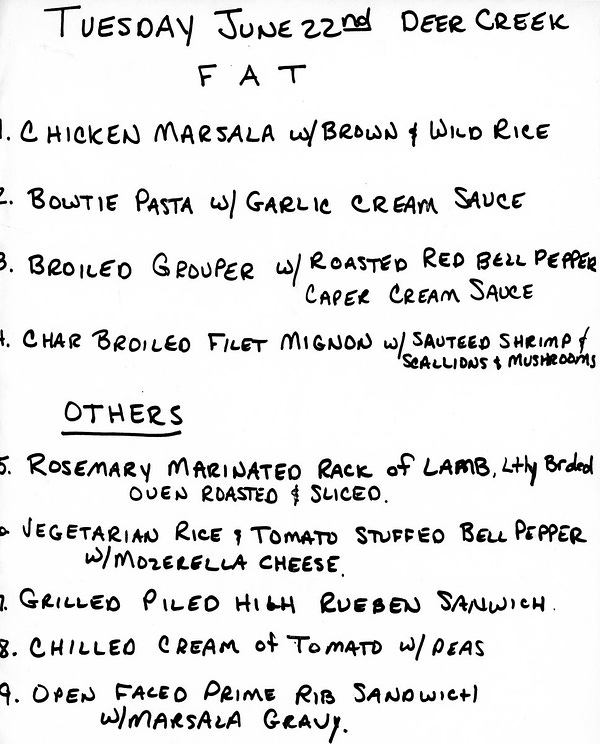
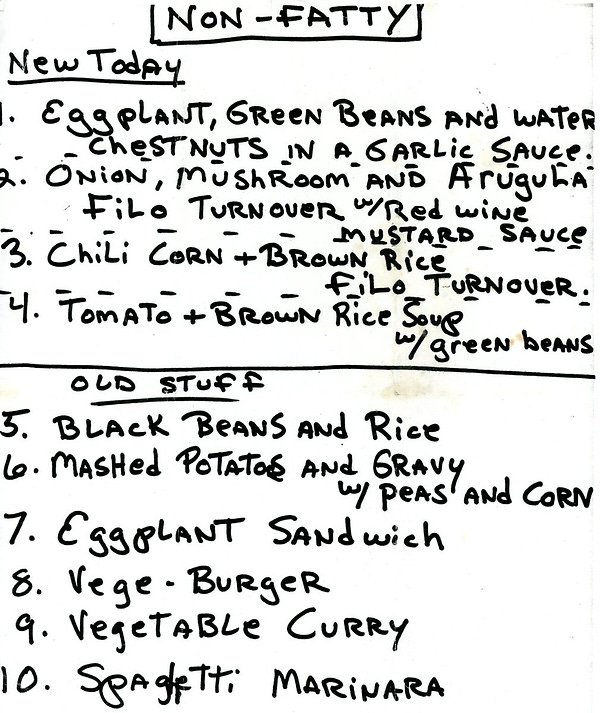
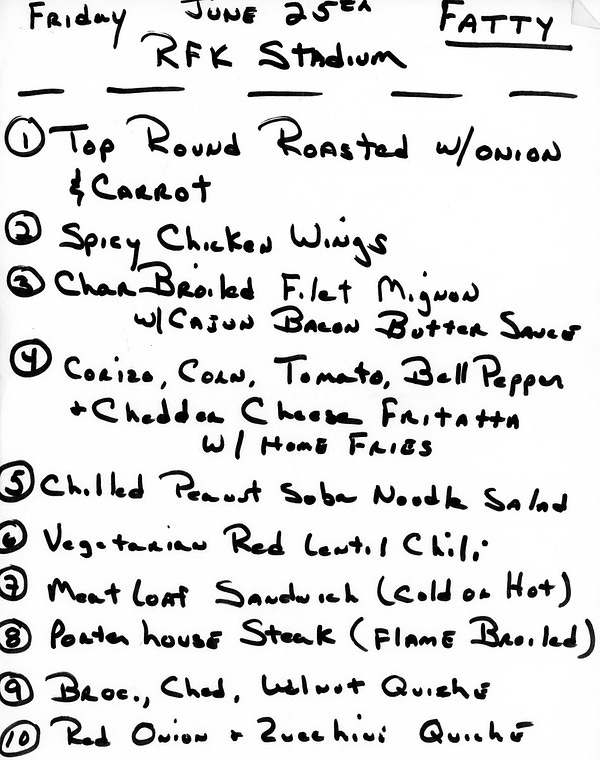
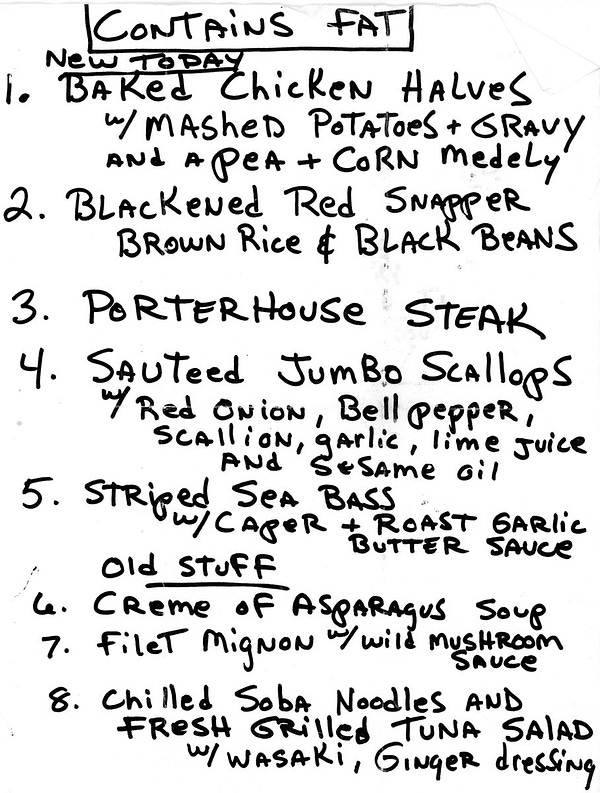
Dylan right underneath that. Dylan attracted the top of the line. His accountant would be out in the house every day counting the seats and matching them up against the tickets that they tore in half. Because let's face it, promoters are shysters, they would sell extra tickets and aisle seats. He was on top of it. [laughs]
What do you remember about the Dylan and the Dead run before the G.E. years?
I remembered I liked Bob with Petty more than I liked Bob with the Dead because, even though I worked with them for 15 years, I just was not a huge fan of the musicianship. You would sit behind them and listen to the two guys drumming, you'd never know they were drumming to the same song.
Billy was an okay drummer. Mickey was— He's got this reputation as “planet drum,” like he's some world class drummer. Oh my god, there could be nothing further from the truth. You’d go out to the house console and Billy's faders would be all the way up in the mix and Mickey's would be way down. People didn't want to hear that.
Yeah, I'm a big fan of Dylan and Petty, more than than Dylan and the Dead
Same here. Much better musicianship. I would like to have seen that collaboration go on longer, but then again, there might not have been a G.E. I thought G.E. and Kenny Aaronson on bass, what a monster. The bass and guitar together were just— god, they were so enjoyable. A lot of times, it's a client, you go out, you don't have to like them. It’s a job and you do the best you can. It's an added bonus if you like the music.
1988-10-16, Radio City Music Hall, New York, NY
Thanks to David, Keith, and Fuzzy for sharing their stories! If you don’t already, subscribe to the newsletter to get more live-Dylan content delivered right to your inbox.
Update June 2023:
Buy my book Pledging My Time: Conversations with Bob Dylan Band Members, containing one of these interviews and dozens more, now!

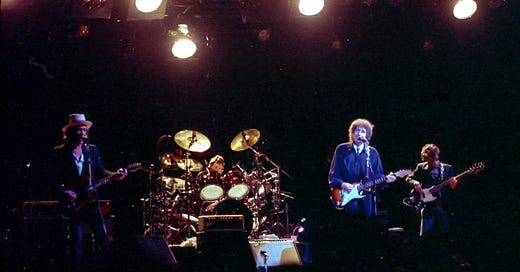


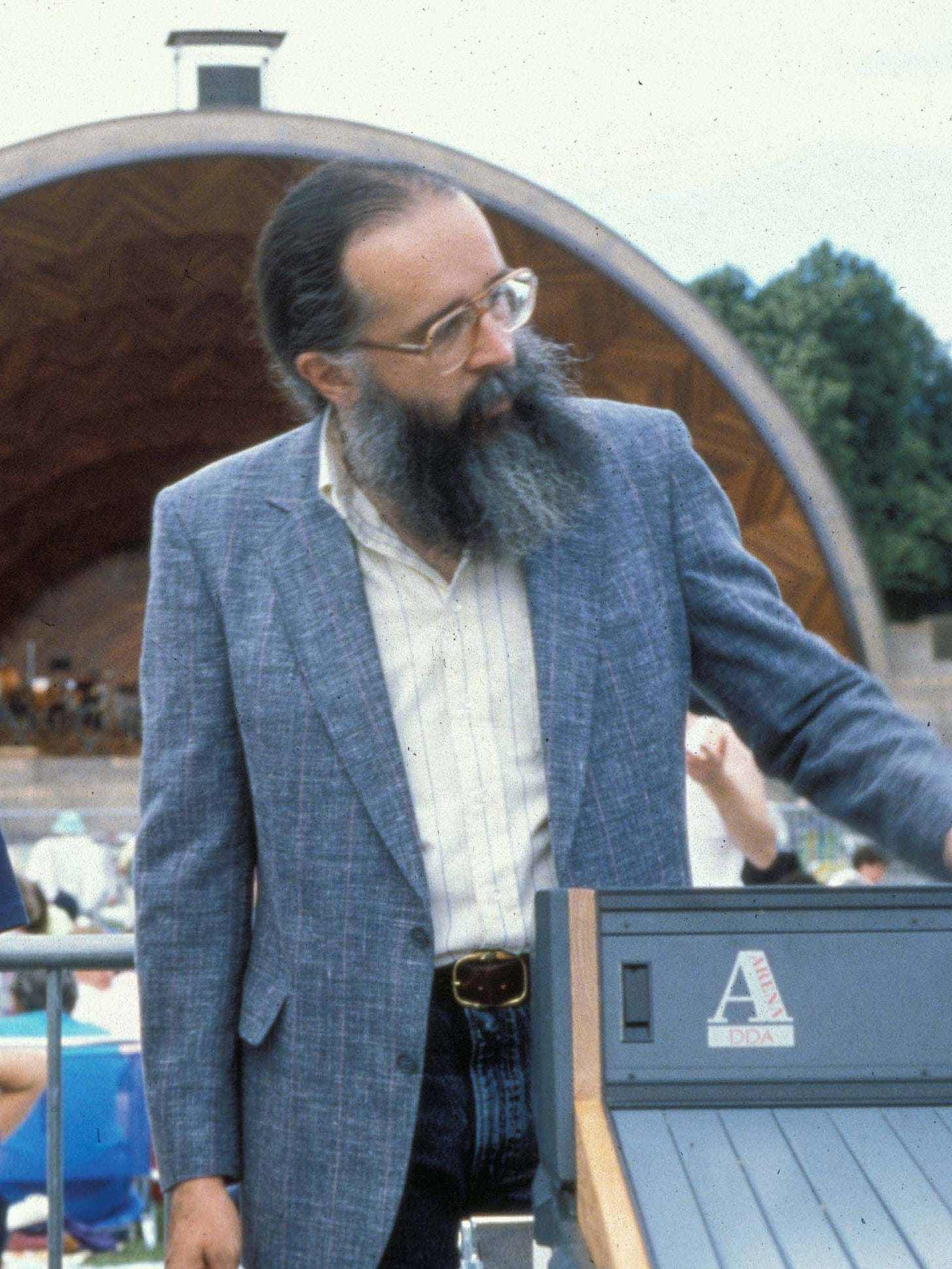
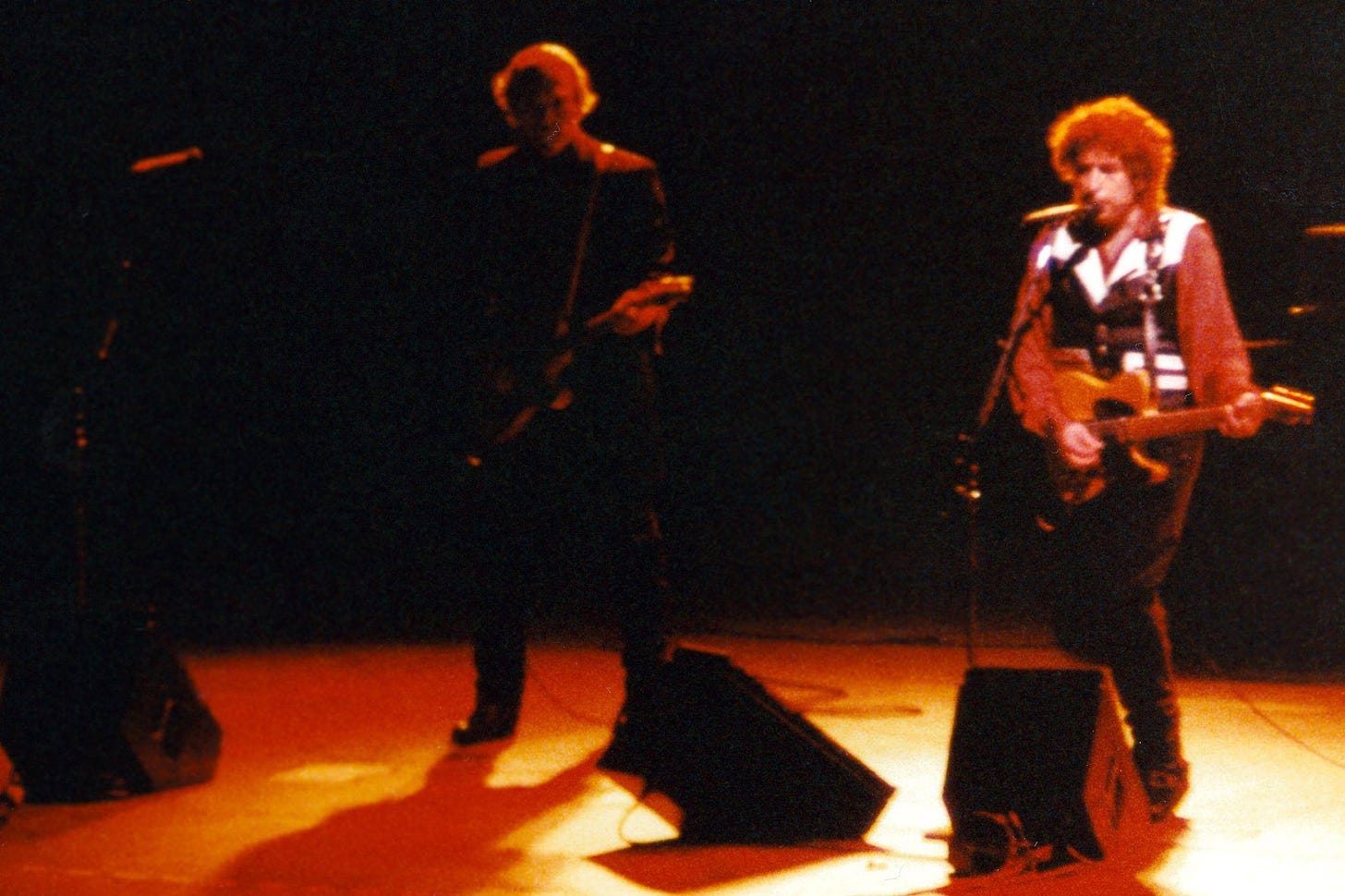

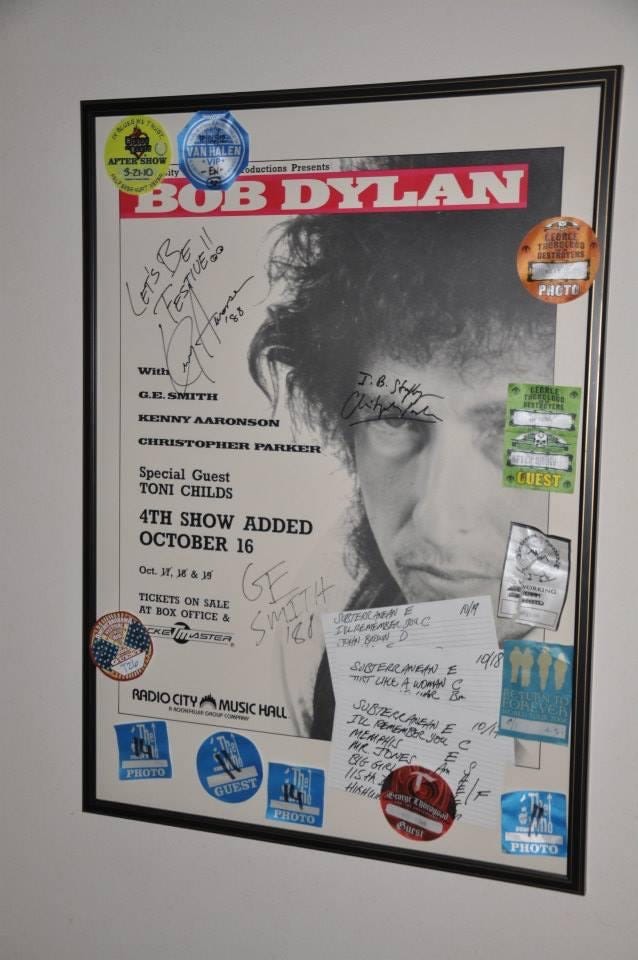
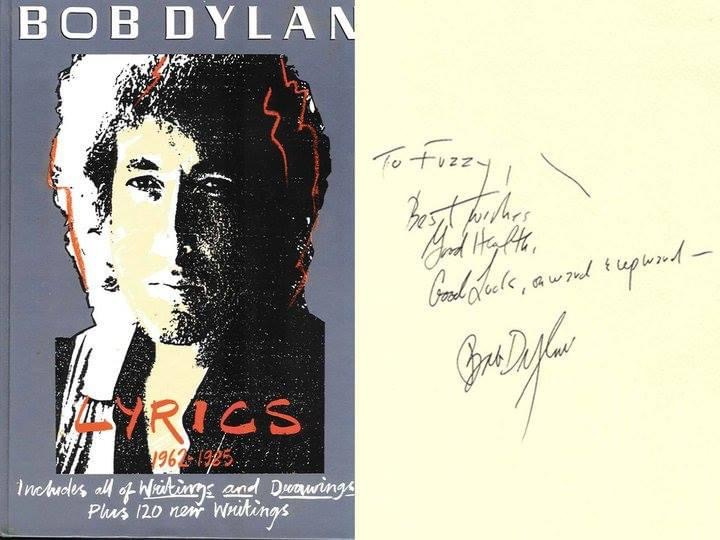

Thanks Ray for accurately portraying our conversations and fleshing out our contributions, especially Dave’s insights and Richards a few posts back. We lived and worked in extraordinary times, and artists of Nobel character to be sure.
A great posting!!! 88' & 89' were some of my very favorite tours. The night I saw Dylan at The Beacon (NYC) in 89' was the most delightful, amazing show I experienced by Bob.
thanks.
Allan Rosenberg (doctored Captain Al)